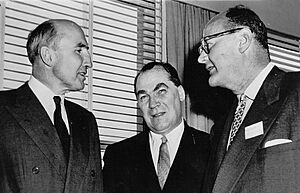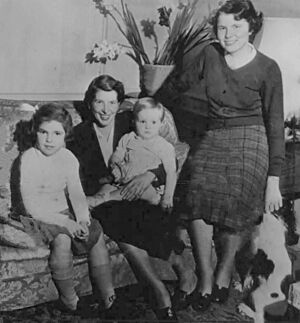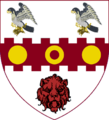Roger Makins, 1st Baron Sherfield facts for kids
Quick facts for kids
The Lord Sherfield
|
|
|---|---|
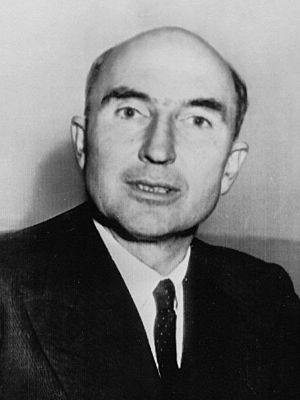
Makins in 1952
|
|
| British Ambassador to the United States | |
| In office 1953–1956 |
|
| Monarch | Elizabeth II |
| Preceded by | Sir Oliver Franks |
| Succeeded by | Sir Harold Caccia |
| Personal details | |
| Born | 3 February 1904 |
| Died | 9 November 1996 (aged 92) |
| Alma mater | Christ Church, Oxford |
Roger Mellor Makins, also known as the 1st Baron Sherfield, was an important British diplomat. He was born on February 3, 1904, and passed away on November 9, 1996. He is best known for being the British Ambassador to the United States from 1953 to 1956.
Contents
Early Life and Education
Roger Makins was the son of Brigadier-General Sir Ernest Makins and Florence Mellor. He went to Winchester College, a famous school, and then studied at Christ Church, Oxford University.
After his studies, he became a lawyer in 1927. However, he decided not to work as a lawyer. Instead, he chose a different path.
Starting a Diplomatic Career
In 1928, Roger Makins joined the Diplomatic Service. This is a group of people who represent their country in other nations. They work to build good relationships between countries.
He worked at the British Embassy in Washington from 1945 to 1947. There, he held the important role of Minister Plenipotentiary. This means he had full power to represent his government.
Later, he worked at the Foreign and Commonwealth Office in London. He was an Assistant Under-Secretary of State from 1947 to 1948. Then, he became a Deputy Under-Secretary of State from 1948 to 1952.
Becoming Ambassador to the United States
In 1953, Roger Makins was given a very important job. He became the British Ambassador to the United States. An ambassador is the highest-ranking diplomat who represents their country in another. He held this position until 1956.
During his time as Ambassador, a big event called the Suez Crisis was about to happen. This was a disagreement over who controlled the Suez Canal. Makins was at a key meeting in September 1956.
At this meeting, some British leaders thought the US President, Dwight D. Eisenhower, would support their actions. But Makins understood the situation differently. He correctly believed that President Eisenhower would not support the British plan.
Career in Public Service
After his time as Ambassador, Makins continued to serve his country. From 1956 to 1960, he worked as a Joint Permanent Secretary at HM Treasury. The Treasury is the government department that manages the country's money.
Then, from 1960 to 1964, he became the Chairman of the United Kingdom Atomic Energy Authority. This organization was in charge of developing atomic energy for peaceful uses.
Leading a University
In 1969, Roger Makins took on a new role. He was appointed Chancellor of the University of Reading. A Chancellor is usually the head or ceremonial leader of a university. He kept this position for many years, until 1992.
Family Life
Roger Makins married Alice Brooks Davis on April 30, 1934. Alice was from America and was the daughter of Dwight F. Davis. Dwight F. Davis was famous for creating the Davis Cup tennis tournament. He was also a former US Secretary of War.
Roger and Alice had six children together:
- Mary Makins (born 1935, a twin)
- Cynthia Makins (born 1935, a twin)
- Virginia Makins (born 1939)
- Christopher James Makins (born 1942, passed away 2006)
- Patricia Makins (born 1946)
- Dwight William Makins (born 1951)
Alice passed away in 1985.
Awards and Recognition
Roger Makins received many important awards for his service. He was recognized with honors from the Order of St Michael and St George and the Order of the Bath. These are British orders of chivalry, given for great service to the country.
In 1964, he was given the title of Baron Sherfield. This meant he became a member of the House of Lords, which is part of the British Parliament. His full title became Baron Sherfield, of Sherfield-on-Loddon.
In 1986, he was also chosen to be a Fellow of the Royal Society (FRS). This is a very special honor given to top scientists and those who have greatly helped science.
Art Collection
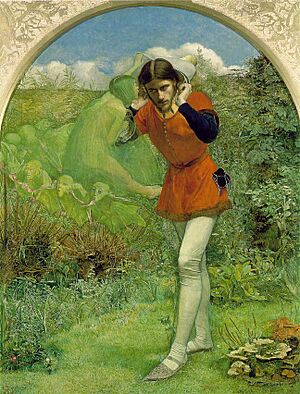
Roger Makins was also known for collecting art. He especially loved Victorian art. His collection included important paintings by the famous artist John Everett Millais.
Images for kids


